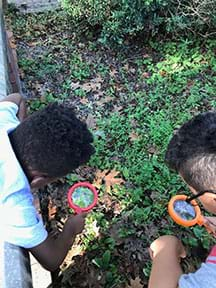Materials List:
Soil from Spoiled:
Engineering a Compost Habitat for Worms
 https://www.teachengineering.org/activities/view/uof-2378-engineering-compost-habitat-red-wigglers-worms
https://www.teachengineering.org/activities/view/uof-2378-engineering-compost-habitat-red-wigglers-worms
Engineering a Compost Habitat for Worms
Each group needs:
- 4 clear containers, 11.5 L (~ 12 qt.) to serve as compost bins
- soil, leaves, and other organic materials found outside for compost; (if the school environment has limited access to organic materials, teachers can purchase various items at a home improvement store and students can choose which to include as their design challenge (for instance: dirt, topsoil, sand, mulch, rocks, leaves, and peat moss)
- cardboard, newspaper, paper, hay, or pine needles to use as bedding for compost bins (see Troubleshooting Tips)
- reusable or compostable cups; used to scoop organic materials from outside
- large plastic bags, 3.78 L (~1 gal); used to hold organic materials before weighing (can be replaced with a sustainable option, such as plastic or glass containers)
- 450 g (~1 lb.) organic waste; students can also collect organic waste around campus, such as fallen leaves or food scraps
- 2 magnifying glasses
- red wiggler worms, 250 count (~50 worms for each compost bin) available at https://www.amazon.com/Uncle-Jims-Worm-Farm-Composting/dp/B00EZPSSGY
- Recycling, Compost, and Garbage Worksheet
To share with the entire class:
- drill to make air holes in compost bins (a heated needle or hot glue gun may be used as an alternative)
- nitrile gloves
- moisture meters, thermometers, and compost turners
- optional: a Worm Farm Accessory Kit with Compost Tools available online is an all-in-one solution that includes a moisture meter, pH meter, thermometer, compost turner, food scrap handling tool, and compost harvesting scraper
- digital scale with tare function that measures in metric and US customary units
- various types of objects to weigh such as gummy bears, sugar, marbles, and blocks
- small plastic bags or containers for objects to be weighed in
- 500 ml beakers for adding water to compost bins when needed (measuring cups or plastic cups can be used as an alternative)
- projector or Smartboard
- tape, glue, or stapler
- scissors
Each student needs:
- chart paper or poster board for presentations
- a lab notebook and pencil
- various colored pencils, crayons, and markers
- Materials List Sheet
- Recycling, Compost, and Garbage Sorting Worksheet
- Parts of a Worm Worksheet
- [optional] Model Habitat Worksheet
Literature:
- The Little Yellow Leaf by Carin Berger, available online
- Compost Stew: An A to Z Recipe for the Earth by Mary McKenna Siddals, available online
- Composting: Nature’s Recyclers (Amazing Science) by Robin Koontz, available online
- Yucky Worms: Read and Wonder by Vivian French, available online
- Wiggling Worms at Works by Wendy Pfeffer, available online
- Diary of a Worm by Doreen Cronin, available online
- Optional book that can be used for teacher’s background research or as a class reference - Compost: A Family’s Guide to Making Soil from Scraps by Ben Raskin, available online

 https://www.teachengineering.org/activities/view/uof-2378-engineering-compost-habitat-red-wigglers-worms
https://www.teachengineering.org/activities/view/uof-2378-engineering-compost-habitat-red-wigglers-worms